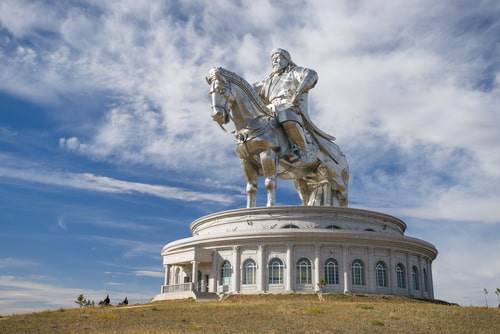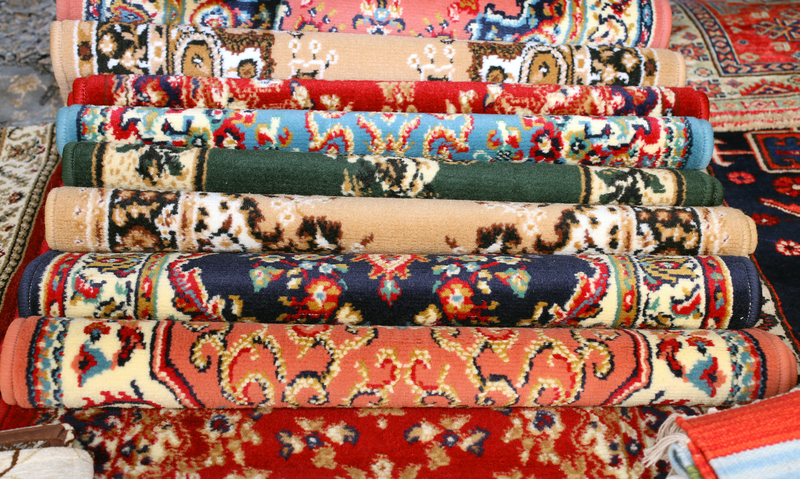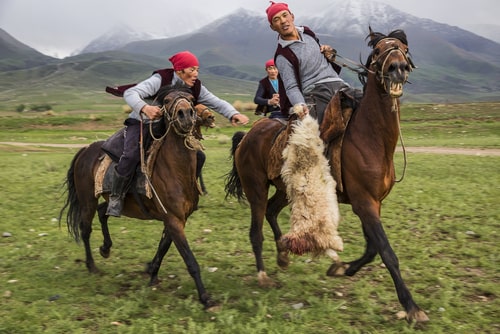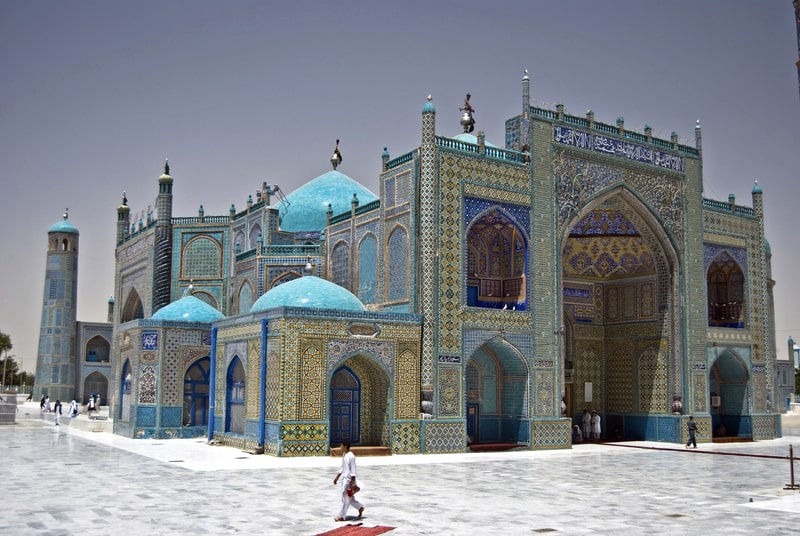Last updated on January 28th, 2024
Afghanistan, officially the Islamic Emirates of Afghanistan, is the 36th most populous country in the world. It has an area of 652,230 sq km. It is a landlocked country in South Asia. Its capital and largest city is Kabul. Pashto and Dari are its official languages. The Afghani (AFN) is the currency of Afghanistan. The native or inhabitants of this country are called Afghan or Afghanistani. It has six bordering countries that include Tajikistan, Turkmenistan, Uzbekistan, Iran, Pakistan, and China. Afghanistan is famous for its pomegranates in Asia. With these facts about Afghanistan let’s explore more about this war-torn country.
The country has been referred to as the “roundabout of the ancient world” as well as the “graveyard of empires.” It has seen many empires expand through the country or else conduct expeditions against it, including Alexander the Great, the British, the Soviet Union, and also the liberation attempt by the United States. The isolated territory is both conservative to change and the repository of vast cultural exchange. It is currently Muslim but has seen Buddhists, Zoroastrians, Khans, the ancient Chinese, and classical Western powers.
The capital of modern Afghanistan is Kabul, a city made important because it was the birth place of the Moghul empire. The city today contains parks and mosques and is the most economically and educationally cosmopolitan city in the country, containing the busiest airport and the bulk of the foreign exchange. The city also lies along the historic silk road and so is a hub along a major Asiatic corridor. Today, the city contains many ruined buildings due to the Afghan war, lengthy resistance, and the slow rebuilding effort by the renewed Taliban government.
Afghanistan on the map
Afghanistan is geographically diverse, being located in proximity to the Hindu Kush mountains. A lengthy mountain range runs through the center of the country while the north has a relative plain and the southwest has a plateau. Only about 12 percent of the landmass in Afghanistan is suitable for farming. The rest is marginally productive and used for animal grazing or other activity. Perennial crops and plants suitable for sloping terrain are common.
Ethnically diverse, about 15 million people in southern Afghanistan are Pashtuns and are distantly related to Persians. Tajiks are Persian but speak another language, while the Uzbeks are linguistically related to Turks and so are a distinct group. Pashtuns in particular are concentrated around Kandahar and are important to relations with Iran.
Afghanistan has a large and mostly unexploited wealth of mineral resources. Since ancient times, traditional metals such as copper and iron have been available in the region as was as the Lapis Lazuli that has been used as jewelry since prehistoric times. For example, the sarcophagus of Tutankhamun contains insets of this blue mineral. More valuable minerals include titanium, uranium, and even gold. The mountain range exposes this wealth closer to the surface, and it largely remains undeveloped.

Modern Afghanistan might be considered to have come into existence with the government established by Ahmad Shah Durrani. This kingdom was not an attachment to a larger empire involving Pakistan and India but a separate country and so solidified the country as a unique polity. The regime was ethnically Pashtun and reflects the constant importance of Iranian relations to the country.
The social, economic, and political turmoil of Afghanistan began in 1979 when the Soviet Union invaded militarily in order to retain its influence in the area. The Soviet Union contained several Islamic-majority countries and wanted to add Afghanistan to its collection. In opposition to this, reformist zealots hoped to wrench the country away from foreign powers forever. The Soviet invasion failed with assistance from the United States and Pakistan.
The Soviet Union attempted to control the country for over a decade, causing the death of a million Afghans and causing destruction to the already sparse infrastructure as well as integrity of the national economy. A puppet communist government also caused a great deal of disruption. Instead of communism, the country came under the sway of diverse Islamist militant groups. The Taliban gained control of the country in 1996 and imposed both repressive measures and also attempted to make the isolation of the country permanent.
The world largely ignored Afghanistan for years after this until affiliated interests used the country as a base for politically-motivated terrorist operations. The United States suffered major terrorist attacks on September 11, 2001 and then invaded the country soon after. A government with Hamid Karzai controlled Kabul with US backing, but the rest of the country remained a political patchwork.
The United States never invested the funds necessary to completely unify Afghanistan under a solid government or to thoroughly develop the country. As large swaths of territory were autonomous and made good bases for resurgent militants, the government in Kabul came under siege nearly as soon as major NATO commitments ended in 2014. The country was over ran with Taliban in 2021 when the United States ended its remaining support.
Interesting facts about Afghanistan
1. The term Afghanistan translates to “the land of Afghans”.
2. The people of Afghanistan are called Afghans and their currency is Afghani. Most of the time, people get confused between the uses of these two terms.
3. Afghanistan is estimated to be inhabited by humans at least 50,000 years ago.
4. Dari Persian and Pashto are official languages of Afghanistan.
5. Pashto, one of the two official languages of Afghanistan, was declared the national language of Afghanistan during the beginning of the reign of Zahir Shah.
6. Dari (Persian), the other official language was always used for government and business purposes.
7. An estimated 35% of the population of the country speaks Pashto while 50% of the population speaks Dari.
8. Afghanistan used to be a country of nomads before they settled down in villages and started cities. These Pashtuns hailed from many different tribes and used to be one of the largest nomadic groups in the world.
9. Did you know that even the Royal family of Afghanistan used to be nomads many years ago? That was at a time when the country was known by another name: Gandhara.

10. Genghis Khan and his Mongol army spread rapidly in Afghanistan in 1219 AD.
11. Ahmad Shah Durrani, also known as “the Father of the Nation”, is the founder of the last Afghan empire. He was crowned in 1747. He consolidated the country from principalities and fragmented provinces into one kingdom.
12. After the death of Ahmad Shah Durrani in 1772, his son, Timur Shah succeeded him.
13. In 1776, Timur Shah transferred the capital of Afghanistan from Kandahar to Kabul.
14. Afghanistan has been a war-torn country for decades and has been under the military influence of many powers including Soviet, British, Mongols, Muslim Arabs, Mauryas, Alexandra the Great, and western powers.
15. Afghanistan became independent on August 19, 1919. They fought three wars with Britain after which they declared themselves independent. They were not directly ruled by the British but their foreign affairs were influenced by the United Kingdom.
16. The Taliban (a Sunni Islamic fundamentalist political movement in Afghanistan) also ruled the country for almost 5 years between 1996 and 2001. The Taliban has retaken control of Afghanistan nearly two decades after they were driven out of its capital by US troops.
17. In 2004, Hamid Karzai became the first democratically elected president of Afghanistan.
18. Many different cultures from surrounding countries had a significant impact on the cuisine of Afghanistan. The main influences are from countries such as Mongolia, Iran, and India.
19. Arab Muslims spread the religion of Islam in Afghanistan in 642 CE in Herat and Zarang. They recognized Afghanistan as Al Hind (due to Afghanistan’s proximity to India.)
20. Buddhism and Zoroastrianism were dominant religions in Afghanistan before the introduction of Islam.
21. Afghanistan is one of the very few countries in the world where there are no public Christian churches. The official state religion in this country is Islam, and more than 99 percent of the population follows it.
22. The only legal Christian building allowed in Afghanistan is the Italian Embassy, known as the Our Lady of Divine Providence Chapel. It is a Catholic chapel and was authorized in 1933.
23. Today, as Islam is a dominant religion in Afghanistan, the culture is heavily influenced by the religion of peace and monotheism.
24. Afghanistan is inhabited by – 80% Sunni Muslim, 19% Shia Muslim and 1% others.
25. More than 90 percent of the population of Afghanistan is impacted by food insecurity and poverty. About 91 percent of the average household income goes for their daily food and other necessities.
26. The busiest bazaar in the open-air market in Afghanistan is the Mandawi. Hundreds of vendors have their products on display for tourists. Local and international products are sold at this bazaar every day.
27. The KFC shops in Kabul, Afghanistan, stand for Kabul Fried Chicken rather than what Westerners are used to. They have foods like chicken, burgers, and pizza on the menu.
28. Afghanistan’s location on the silk route gave it various economic and cultural advantages.

29. Afghan rugs are very popular around the world.
30. Agriculture is the main source of income for Afghans. Afghanistan is also rich in natural resources like natural gas and oil.
31. Afghanistan also has a wide range of mining resources at its disposal, which includes rare earth elements like gold and zinc. The country is known as the Saudi Arabia of lithium.
32. Oil is also available as a natural resource in Afghanistan, and the Taliban started extracting it from the earth.
33. Afghanistan boasts four large cement factories to help boost its economy. They may not be the largest factories in the world, but they produce around 600 tons of cement every day in the Baglan Province.
34. Afghanistan may have an arid climate, but they still produce a wide range of fresh fruits every year. Some of the finest fruits from this country are grapes, pomegranates, Melons, and mulberries.
35. Afghans don’t like their food too spicy or hot, but they produce a large number of spices. Included in the list of spices are wild black cumin, dill, coriander, and fennel.

36. “Buzkashi” is Afghanistan’s national game. Players in two teams try to catch a goat while riding a horse. This game is being played for centuries and is a tough sport. Many Afghans would love it to become an Olympic Sport.
37. They have a variety of sports, but soccer and cricket are the most popular in Afghanistan. The country takes part in various cricket leagues and even won the Asia T20 Cup in 2010. (India defeated Sri Lanka by 81 runs in the final to win a record 5th Asia Cup title.)
38. Arnold Schwarzenegger is the poster boy in many of the muscle building centers in Afghanistan. They say he (Arnold Schwarzenegger) looks like an Afghan.

39. New Year is celebrated by Afghans on 21st March. They call it “Nawroz”. It is a pre-Islamic festival which is celebrated by a gathering of thousands of travelers from across Afghanistan to the city of Mazar-e-Sharif. There is a mosque in the center of the city. It is known as the Blue Mosque or ‘the Shrine of Hazrat Ali’ the cousin and son-in-law of the Islamic prophet Muhammad (P.B.U.H).
40. Afghanistan’s national holiday is on August, 19.
41. To many Afghans, the 1st of January is their day of birth. That is due to the ten-year war from 1980 to 1990, when most citizen records were lost.
42. They celebrate poetry night on Thursdays in the western city of Herat. People of all age groups gather there to share modern and ancient verses of poetry and indulge in some nice food along with some sweet tea.
43. In Afghanistan, most of the shops and businesses are closed on Friday, which is the Islamic holy day.
44. The legal, political, economic and personal life of the Afghans is governed by Islamic laws.
45. Fasting and praying during the month of Ramadan is a mandatory act except for a few such as foreigners, and those who are sick, traveling or having some other issues.
46. An interesting fact is that 67 percent of the Afghanistan population is younger than 25 years of age. It places this country in the top spot with the youngest population in the world.
47. The average life expectancy at birth in Afghanistan is 53.25 years (2021).
48. In the past few years, an estimated 2.6 million Afghans left their home country and sought refuge in others.
49. The family is an important aspect of Afghanistan’s culture. Men are laden with the responsibility to earn while women are expected to stay home and serve the family. However, in modern Afghanistan, you may also find some women working in the cities and earning a living for themselves and their families.
50. In most of the cases, the family lives together in the same house. Upon marriage, the son and his wife live separately in a different room in the house under the same roof.
51. Living together in a common house is encouraged but never forced. Depending on the financial condition or personal preference, the sons of the family can live separately or with his father, mother and other siblings.
52. Hospitality plays a significant role in the country’s culture and tradition. The visitors are treated with the utmost respect and are offered the best that the household has.
53. Food is generally served on the floor, on clothes made from various materials. Making use of the right hand while eating the food is the norm, and the food is generally shared from the same dish unless required otherwise.
54. The host does their best to serve the best possible food, and special attention is paid to fill the visitor’s plate when it is empty.
55. While consuming food, it is also a norm to sit in a respectable position and not with your feet facing people or your legs outstretched.

56. Gifts are a means of strengthening the relationship between a visitor and his/her host. The visitors can carry a small gift for the host when invited for tea or food.
57. Alcohol is primarily illegal in Afghanistan, but some restaurants are allowed to serve it. They are not allowed to sell any liquor or alcoholic beverages to Afghan Muslims, but only to foreign clients.
58. Interestingly, Afghanistan is only one of about 11 countries around the world where alcohol consumption is illegal for all ages. It is because of the Sharia Law in Afghanistan.
59. Women are highly respected in society and are not expected to mix with the members of the opposite sex, except out of marriage or direct family relations.
60. Direct eye contact between men and women is not considered acceptable and must be avoided.

61. A handshake is the most usual form of greeting in Afghanistan’s culture. Some people also place their hand on their heart and nod slightly to show respect and approval to the other party. However, shaking hands between the members of the opposite sex is not usual and is avoided.
62. Afghanistan is currently the only country in the world where education for women is not allowed. That may be because of the deep belief in the country that only men should provide for the women and children of their families.
63. Literacy rate in Afghanistan is 37.3%.
64. Women are also expected to wear clothes that honor their modesty and are not revealing. Tight clothes and western dresses are not much welcomed in society, at least in rural areas. Headscarves for women are advisable.
65. Marriage is considered an important element of one’s life in Afghanistan. Divorce is rare and is not much welcomed in society.
. . . continue reading facts about Afghanistan on the next page
